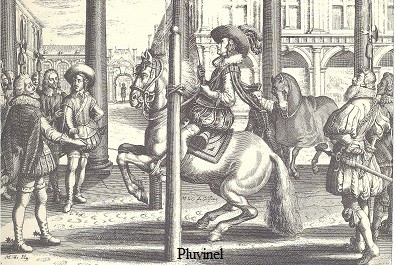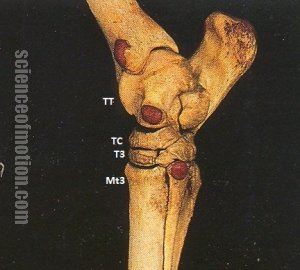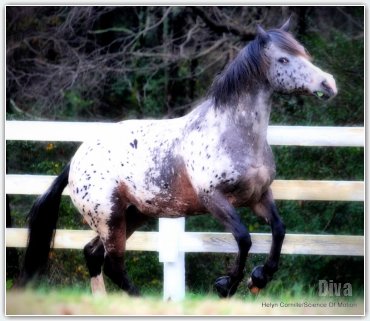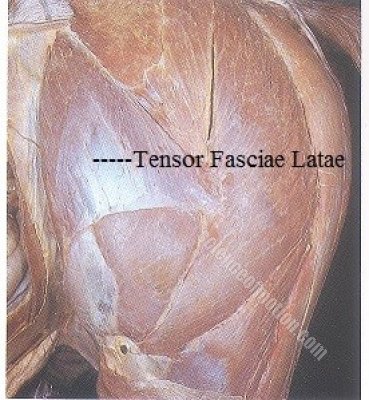The rational for not touching the horses’ limbs
The rational for not touching the horses’
limbs with a whip or any other rod.
by
Jean Luc Cornille
Because these techniques please your fantasies but cripple your horse. Our ancestors did it creating the classical picture of a classical Master touching the horse limbs with a whip. Our ancestors only had visual references or very basic static anatomy.  They were not aware that inward rotations, medial to lateral and lateral to medial occurred within most joints in synchronization with their flexion and extension. If a stimulus such as the touch of a whip modifies the kinematics of the lower leg in relation to the upper leg or vice versa, dysfunction is created altering proper synchronization between flexion and extension of the joints and inward rotations. James Rooney demonstrated that if a stimulus, such as the touch of a whip, provoked early impact of the distal hind limb, abnormal rotation of the lower joint will create sharing forces and consequently risk of arthritis between MT3 and T3. At the contrary, if the stimulus of the whip places the lower leg more forward in relation to the upper leg, sharing forces and risk or arthritis will occur between T3 and TC
They were not aware that inward rotations, medial to lateral and lateral to medial occurred within most joints in synchronization with their flexion and extension. If a stimulus such as the touch of a whip modifies the kinematics of the lower leg in relation to the upper leg or vice versa, dysfunction is created altering proper synchronization between flexion and extension of the joints and inward rotations. James Rooney demonstrated that if a stimulus, such as the touch of a whip, provoked early impact of the distal hind limb, abnormal rotation of the lower joint will create sharing forces and consequently risk of arthritis between MT3 and T3. At the contrary, if the stimulus of the whip places the lower leg more forward in relation to the upper leg, sharing forces and risk or arthritis will occur between T3 and TC 
It was originally believed that limbs movements were creating back movements and in fact, until Kevin Haussler questioned the theory, the common veterinary practice was injecting the hocks as the root cause of back pain. Haussler wrote in 1999, “As a profession, our task is to acknowledge that primary back problems do exist in horses and that more research needs to be conducted on spinal disorder and their effects on health and performance.” (Kevin K. Haussler, DVM, DC, PhD. 1999) More researches have been conducted and the science of motion is the practical application of advanced researches.
In 1980, Leo Jeffcott wrote, “The biomechanics of the vertebral column, although very complex, are of vital importance because they form the basis of all the body movements.” (Natural rigidity of the horse backbone, 1980) We explored the thought for the purpose of better preparing horses for the athletic demand of the performance. Shortly after the publication of Jeffcott study, I removed my spurs realizing that instead of better coordinating the horse’s vertebral column, I was resolving difficulties increasing the propulsive activity of the hind legs. I was not coordinating the horse’s physique for the effort; instead, I was rushing the horse into performances taking credit for achievements that the horse performed out of his talent and definitively not out of my spurs. It was a decisive step toward a paradigm shift rediscovering that the horse thoracolumbar spine was indeed the source of all body movements including the beauty and the soundness of the limbs movements. I use the word rediscovering because great riders had previously discovered the same phenomenon but did not have the intellectual curiosity or possibility to study the phenomenon from a scientific perspective and therefore have been unable to explain it and teach it.
The first discovery was that upgrading riding and training techniques to actual knowledge; it was possible to “create” world class movers. “Create” is incorrect; we observed that in fact, many horses were potentially great movers but their talent was marred by unsophisticated riding and training techniques and consequently poor body coordination. The horse presented on this short video was a beautiful Holsteiner trapped in poor body coordination. He was sold to us for a low price because of his mediocre gaits. No need to say that before conceding failure several highly renowned trainers have tried to extract the gaits that the horse morphology allowed to expect. We taught him how to use his back properly and in a relatively short period of time, his talent exploded. Not every horse has the power for such suspension and amplitude but most horses have potentially gaits that conventional approaches never fully expose. The horse evolution has been exclusively done through proper development and coordination of the back muscles. Not once a whip or any other utensil ever touched his legs
The next logical step was the practical application to therapy. As it was possible, through sophisticated orchestration of the equine back, to sublimate hind and front limbs movements, it was theoretically possible to correct limbs kinematics abnormalities and consequent injuries. In hand, and through sophisticated coordination of the back muscles, it became possible to precisely control, direction, intensity and duration of the front limbs hoof placement. If you remember Diva’s story; she regained mobility and happy life in spite of double ring bones. This is how the rehabilitation was done.  Due to her morphology, she stood with the forelegs backward underneath her body. The farrier improved the angle of the coffin bone shifting the shoe backward and we realigned the second phalange shifting her all body backward. This was done through proper development and coordination of her back muscles. The work was initially done in hand as she was not capable of carrying a rider. Once her back muscles had developed enough for the weight of a rider, the work was continued under the saddle.
Due to her morphology, she stood with the forelegs backward underneath her body. The farrier improved the angle of the coffin bone shifting the shoe backward and we realigned the second phalange shifting her all body backward. This was done through proper development and coordination of her back muscles. The work was initially done in hand as she was not capable of carrying a rider. Once her back muscles had developed enough for the weight of a rider, the work was continued under the saddle.
Just by understanding how the hind and front limbs truly function, it is not difficult to comprehend why external stimulus on the lower or higher limbs, such as the touch of a whip, would disrupt sound kinematics. External stimulus are inevitably chaotic in the sense that they disrupt the normal cycle of locomotion at many levels. In their award winning article, “Horses damp the spring in their step,” Allan Wilson, Polly McGuigan, Anne Sue and Antony van den Bogert, reminded the fundamental principle of equine locomotion. Much of the musculotendinous length change required for generating locomotion occurs not in the muscle fibers themselves but by elastic recoil of the associated tendons and muscle aponeurosis. “Length change occurs by a stretching of the spring-like digital flexor tendon rather than through energetically expensive length changes in the muscle.” Tendons and aponeurosis store energy during the support phase that is used for the following swing phase. One of the main functions of the associated muscles is to damper the high-frequency oscillations in the tendons. In normal locomotion, the tendons vibrate at high frequency, 30-40 Hz that could cause fatigue damage to tendons and bones. The associated muscles are constructed to damper these high frequency vibration. Would their precise work being disturbed by a touch of the whip, the stability of the limbs structure would be compromised. Quite often, a technique that apparently works at simplistic level does not work at a more educated level.
We have learned through the comments of our many publications that when someone wants to protect old theories, one will always look for the detail that can serve one’s belief. As we talk here about the lower leg, one will oppose that one only touch the upper leg. The problem is that the same principles apply.  The hind leg protraction is initiated at the end of the stance by active shortening of the hip flexor muscles, but is maintained through the forward swing by recoil of elastic strain energy stored in aponeurosis such as the ones of the tensor fasciae latae during the stance. If the support phase is disrupted ,or accelerated, or shortened or simply muscles are contracted out of their synchronization by a touch of the whip, proper storage of energy is not achieved and the horse has to compensate by greater muscular work. These techniques do not enhance the limbs biomechanics. They create instead pathomechanics, which defines improper kinematics inducing pathological changes and therefore injuries.
The hind leg protraction is initiated at the end of the stance by active shortening of the hip flexor muscles, but is maintained through the forward swing by recoil of elastic strain energy stored in aponeurosis such as the ones of the tensor fasciae latae during the stance. If the support phase is disrupted ,or accelerated, or shortened or simply muscles are contracted out of their synchronization by a touch of the whip, proper storage of energy is not achieved and the horse has to compensate by greater muscular work. These techniques do not enhance the limbs biomechanics. They create instead pathomechanics, which defines improper kinematics inducing pathological changes and therefore injuries.
Those are simply examples. It would take a very large book to review all muscles, tendons and aponeurosis involved. These examples explain that a precise coordination is involved which, if disturbed by local action of a whip or other utensil on the lower or higher limb, the leg will not be able to store adequate elastic strain energy for the swing phase. Problems such as dragging the toes or early impact of one hind leg often results from this simplistic form or education. The forelegs function under the same principle and flat trot, short strides, lack of suspension are very often the outcome of theories and training techniques focusing on the limbs instead of the source of all body movements, including the limbs, which is the back.
Unfortunately, horses compensate. The term unfortunately is used here instead of fortunately because the horse talent maintains the rider within the belief that bad training technique do work. “Unfortunately,” is also because in many instances, the horse compensations induce deeper kinematics abnormalities and greater problem. If for instance the horse responds to the stimulus of the rider’s whip without adequate coordination of the thoracolumbar spine and consequent dorso-ventral rotation of the pelvis, the horse might achieve greater engagement of the hind limb increasing the rotation of the femur around the hip joint. This would disturb the normal inward rotation of the femur around the tibia placing the stifle at risk of upward fixation of the patella. Once again, the horse will avoid accidental lock of the patella through quick contraction of the quadriceps and biceps but jamming will occur damaging the joint. Touching the horse limbs with a whip or a rod does not enhance the horse biomechanics, it is nothing more than pathomechanics.
“But everybody does it!” Yes and very good masters did it in the past. It is doubtful that they would do it today in the light of new knowledge. They would apply a better approach. The better is the practical application of Leo Jeffcott statement. The biomechanics of the vertebral column form the basis of all the body’s movements. Quite evidently, the biomechanics of the vertebral column cannot be soundly coordinated applying techniques based on antiquated knowledge of the equine vertebral column mechanism. Orchestrating the equine thoracolumbar spine is like directing a large orchestra. One needs turning his or her back to the crow. The past gave wisdom, which can only become sound performance and efficient therapy if updated to actual knowledge. It is a wonderful world. There is no lateral bending of the neck, no shift of the rider’s weight, no relaxation of the rider’s back, no stretching, no heavy weight on the bit. The rider seat in authentic neutral balance and it is all about nuances in muscle tone directing the horse’s brain toward the most efficient body coordination. It is the equestrian art, which is not an easy one but an intelligent and fascinating world. Is it easy to learn?, yes and no. Yes because young kids, who have not been damaged with obedience to the rider’s aids, leadership via submission and other misconceptions, are very comfortable with the concept of minimum movement, slow work, energy, integrity of the whole body. The No is not about learning the new technique but about letting go the old one. Alwin Toffler wrote, “The illiterate of the 21st century will not be those who cannot read and write, but those who cannot learn, unlearn, and relearn”. Every member of our online and mailing course will tell you; “It is hard,” but not one would ever return to the pulling, stretching, pushing, fast-forward, spurs, relaxation and all these theories that crippled their horse and their own body and pushed them to look for a better way.
Jean Luc Cornille
12/21/2014


